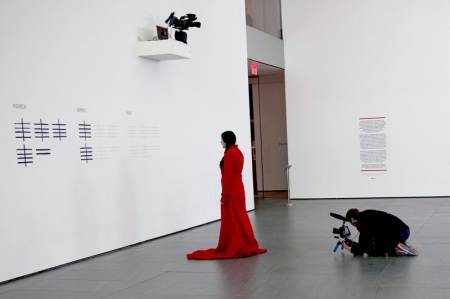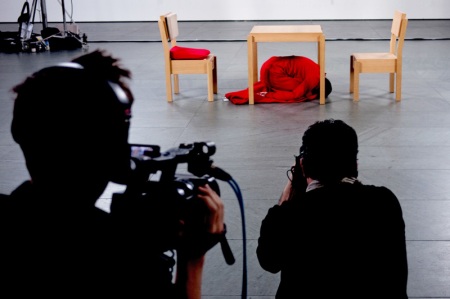Outtakes from my interview with Marina Abramović

Marina Abramović and filmmaker Matthew Akers.
Photo: David Smoler. Courtesy of HBO and Music Box Films.
So last week, I had the momentous opportunity to interview Marina Abramović via Skype for the LA Weekly. The edited interview, which contains all the juiciest bits where she dishes at length about the 2011 MOCA Gala, her long-running conflict with Yvonne Rainer, the “unoriginality” of Dawn Kasper’s Whitney Biennial installation, how she didn’t get paid “one penny” for her Seven Easy Pieces show, and how the underground is for “plants,” appeared today on the LA Weekly arts blog. As a special bonus for ART! readers, I am posting below the parts of the interview that didn’t make it into the final cut.
Can performance art really be taught?
I think yes, because I’ve been doing now 27 years, teaching a lot—in Germany, France, Japan, so many different countries. First of all, it’s the same as painting or sculpture, you can teach the painting but you can’t make the great painter. You have to have what I call charismatic state of being. Let’s start from the beginning. When a student comes and says “I want to be a performance artist,” I am first questioning if they are an artist at all—sometimes they just want to be a little famous or something stupid like that. Then, if you are really an artist, you have to find which real media is good for you.
Sometimes you think you are a performance artist but you actually can’t perform. So it’s not easy, but what I can teach people is how to condition the body and the mind to get to that state, and then it’s up to them to do the performance. There’s lots of techniques which I kind of mixed up. I can teach them how to reduce things, how to begin, how to document, which mistakes they should not make. Lots of things I learned, I can give this kind of advice. So yes, you can teach performance, but you can’t make someone great. It’s a genetic thing, you either have it or you don’t have it.
I noticed in the film that you employed some very specific teaching techniques at your performance art “boot camp”—breathing exercises, counting grains of rice, etc. Where do these techniques come from?
Oh god, it’s a huge mix. I spent one year with the ______ [inaudible and I forgot to check with her], the Shamas in Brazil, Tibetan Buddhism, Sufism—so every single exercise I try on myself, reduce the ones that don’t work, and I took the ones that do. It’s my own personal mix.
I totally get what you’re doing, but part of me also thinks, performance is so transgressive and so dependent on the live moment, that I wonder if, once you place it in an institution, does it change the performance, does it become something else?
What do you mean by institution? First of all, institute is going to have archive. The archive is archive, does it become something else? You go and study what happened before. And then I will have the course for the public. Because nobody ever teach the public how to see something which is long durational. They lose concentration in three seconds and go away because our entire American culture is made that way that you can’t concentrate on anything. I mean nobody look the one program on television because advertising interrupt you all the time. So our mindset is not made for long durational work.
So I think it’s necessary for public to teach them. So it’s not changing anything, it’s just teaching them, and then to see the piece of work which is uninterrupted, as a refreshment to everything else in this country, is interrupted every five minutes. So the thing is different—it’s not institution, it’s making the kind of setup, the space, where people could experience something different.

Marina Abramović and filmmakers Matthew Akers and Marcus Anelli. Photo: David Smoler. Courtesy of HBO & Music Box Films.
You said performance at your institution will be a six-hour minimum, right?
Yes, you have to sign me contract to give me word of honor. So if you don’t spend six hours, then you break your word of honor, it’s not my problem. But word of honor is word of honor, I think it should be respected. And then if you give me your time, I give you experience. If you don’t give me time, there is no experience.
I’ve seen a lot of performances in L.A., and I don’t think I’ve ever seen one that was longer than 20 minutes.
Well exactly! Because you know, the artist creating work of art to accommodate the lack of attention of the public. You remember in the ‘80s and ‘90s all the videos were 30 seconds and they were looped? It was all in slow motion, I was so bored with this. They were performed in front of the camera and then looped. So this means that artificially, you have a sense that this continues, but the artist didn’t get the experience, so they never changed. The deal is that the artist AND the public have to get the experience, not just being done by editing, you know. It’s really different approach. Twenty minutes I think for Los Angeles is super long! Because life is so fast there too.
[More on the Yvonne Rainer controversy]
My best answer to all this is that people who participated in this experiment and wrote to her emails to say that they find abuse, you know that thing that the stupid young kids being manipulated. But they have their own mind, and they will do it again. And you know the situation with dance is so much worse than performance, dancers are treated very badly, they are very underpaid, they always end up with terrible injuries to their bodies…
Anyway. But I really think is more of a position of Yvonne Rainer, because you never heard about her and now all newspaper is writing—it’s more her position. It’s so sad that she took this as example. I think that she deserve much better position for her own achievements. Because you always have to see bitterness of people and their background, why things are the way they are. I was only used for so many different reasons and issues that she wants to put out. And she’s such a hardcore feminist! I don’t like this. I always say, yes I’m female, but I’m not female artist, I am just artist. Artist don’t have gender, it’s just good or bad art, that’s it. I never feel abused, I never feel rejected—I always felt equal, maybe even more powerful. Just the fact that the female have this ability to make the life, makes us so much more superior! I never felt inferior, I don’t get it. That’s my point.
People do often bring their own agendas, as opposed to being open to what is really intended by the artist.
I was so disturbed with my MoMA retrospective, I have this piece Imponderabilia, where the people are standing in the door of the museum and you have to pass through. And even Barbara Walters on the TV, she said she brushed half an erection, and everybody just talk about stupid body. Nobody see this as a poetical gesture: if there is no artist, there is no museum, the artists are door of the museum, this was the whole idea. And in ’77 we made this piece, and now we redone it, and America is so busy with nudity. Can you relax and be normal? Come on.
You know that most of the important performance pieces, they will never be made in America because of so many restrictions, liability cases that you have to send lawyers, what you can do and not do, and we in Europe did it. I mean just this piece with the bicycle seat, the day before the museum opened, the two lawyers for MoMA come and say okay, the woman sitting on the bicycle seat on the wall, she have to have a belt and helmet, and security will have a rope, and she can only do 15 minutes. It’s not my piece anymore!
In the last five years, performance art has become so trendy that Lady Gaga says she’s a performance artist, Rachel Maddow called Herman Cain a performance artist because he was just so ridiculous as a politician, etc. All of a sudden, everything is performance art. What do you think of this?
Always the fashion. It’s very clear, what’s performance art and what’s not. It’s the context that makes difference. I mean, the politicians is politicians and Lady Gaga is musician, and that’s all it is. It’s a medium. People say live television is a performance, and it’s not. That’s why this movie, The Artist Is Present, is important and I really put so much effort to be made, to understand that performance is serious business and not that easy to do, and that’s really important. You know, in the ‘70s, it was so many shitty performances that I was almost ashamed to say I was performance artist. Because everything was performance—it was a woman putting eggs in vagina and waiting for the chicken, it was really stupid thing. I mean things like that, I was just fed up.
It’s still true though, there’s still a lot of bad performance art out there.
You have to move for the piece really transform… I have the next interview by the way. It’s 2:31. I keep talk so much. Kiss for me! Bye.
Marina’s documentary film, Marina Abramović The Artist is Present, opens for a one-week run on June 15 at the Nuart Theatre. It will also air on HBO beginning July 2.
June 20, 2012 at 2:33 pm
I am a friend of Nicole Antebi! She sent me over here to your site. I love it and I’m excited to read more.
June 20, 2012 at 5:11 pm
Thank you and welcome!